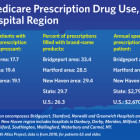State Suspends License Of Stamford Doc For Excessive Use Of Alcohol, Drugs
|
The state Medical Examining Board on Tuesday suspended the license of a Stamford doctor after state Department of Public Health officials said his excessive use of alcohol and drugs and his mental illnesses may affect his ability to safely practice medicine. A statement of charges against him says that Dr. Jeffrey Stern excessively used alcohol and narcotics in 2019 and 2020 and since 2019, has had mental illnesses or emotional disorders. DPH records show that Stern was arrested on Aug. 29, 2020 and charged with possession of drug paraphernalia with intent to use and driving while intoxicated. It was unclear where the arrest took place.



